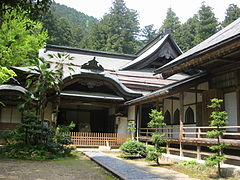Kegon-ji
The Kegon-ji ( Japanese 華 厳 寺 ), also known under the mountain name Tanigumi-san ( 谷 汲 山 ), is a temple of the Tendai Buddhist movement. The temple is located in Ibigawa in district Ibi in Gifu Prefecture , Japan. It is the 33rd and last temple on the Saigoku pilgrimage route in traditional counting .
history
According to tradition, a certain Ōguchi-dairyō from the province of Mutsu had an eleven-faced Kannon carved in Kyoto in 798 . On his return trip he was told in a dream to leave the Kannon at this point. When a place of prayer was built here, an oil gushed from the rocks, with the help of which the Kannon could be illuminated. This is how the name Tanigumi 'valley filler' came about. When Emperor Daigo heard of this miracle, he gave the temple a tablet with the inscription "Tanigumi-san" in 917. In 944, Emperor Suzaku made the Kegon-ji a temple of devotion.
The attachment
At the foot of the hill is the temple gate ( 山門 Sanmon ), which is designed here as a Niō gate ( 仁王 門 Niō-mon ), i.e. as a gate with the two temple guards to the right and left of the passage. Here it has the shape of a two-story gate with an intermediate roof (二 重 門, Nijū-mon). Then you climb up a long stone staircase and get to the main hall ( 本 堂 Hondō ; 1). To the left of the main hall is the Oizuru Pavilion ( 笈 摺 堂 Oizuru-dō ; 2). Since the Kegon-ji is the last one on the Saigoku pilgrimage route, the pilgrims hand over their pilgrim garb ( 笈 摺Oizuru ), the pilgrim's stick, the umbrella and other items to the pavilion and sing while they recite "The pilgrim garb that has served us well so far, let's cast off now. Tanigumi by Mino . ”To the east of the main hall is the bell pavilion ( 鐘 堂 Shōdō ; 3).
The temple also includes the refectory ( 庫裏 Kuri ; R) and the guest house ( 内 仏 客 殿 Naibutsu Kyakuden ; G). In the southwest is the Great Inari Shrine ( 稲 荷 大 明 神 Inari Daimyōjin ).
Temple treasures
In the main hall, the main cult figure , an eleven-faced Kannon, is accompanied by the holy Bishamon ( 木造 毘 沙門 天 立 像 Mokuzō Bishamon-ten ritsuzō ), who was made from a piece of holu. The Jōgan era ( 貞 観 ; 859–877) is assumed to be the time of origin of the sculpture . The sculpture is therefore a good example of the elegance of the Fujiwara period or early Heian period . It is classified as an Important Cultural Asset of Japan .
Another important cultural asset of Japan is the picture with Kannon figures ( 絹本 著色 三十 三 所 観 音像 Kempon chakushoku, sanjūsan-jo Kannon-zō ) from the Kamakura period with the dimensions 2 × almost 1.5 m , which is applied in color to silk . Amida Nyorai ( 阿 弥陀 如 来 ) can be seen in the middle , he is surrounded by 33 Kannon figures. Among such representations, this picture is the oldest and largest. It is kept in the Osaka Art Museum.
photos
Remarks
- ↑ A Ōguchi-dairyō ( 大 口 大 領 ) was a large farmer with administrative authority in ancient times.
literature
- Gifu-ken kotogakko kyoiku kenkyukai komin-chireki-bukai, chiri-bukai (Ed.): Kegon-ji . In: Gifu-ken no rekishi sampo. Yamakawa Shuppan, 2006. ISBN 978-4-634-24621-8 . Pp. 127, 128.
Web links
Coordinates: 35 ° 32 ′ 14.5 " N , 136 ° 36 ′ 28.4" E






